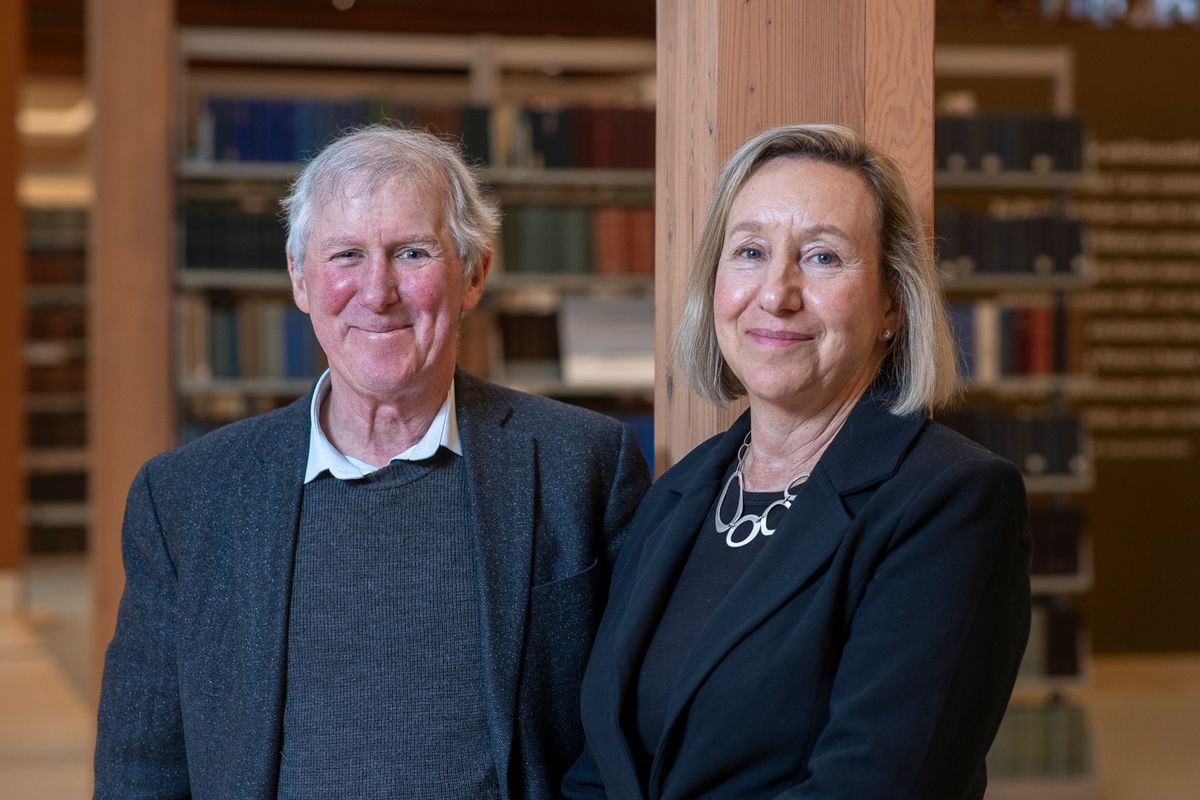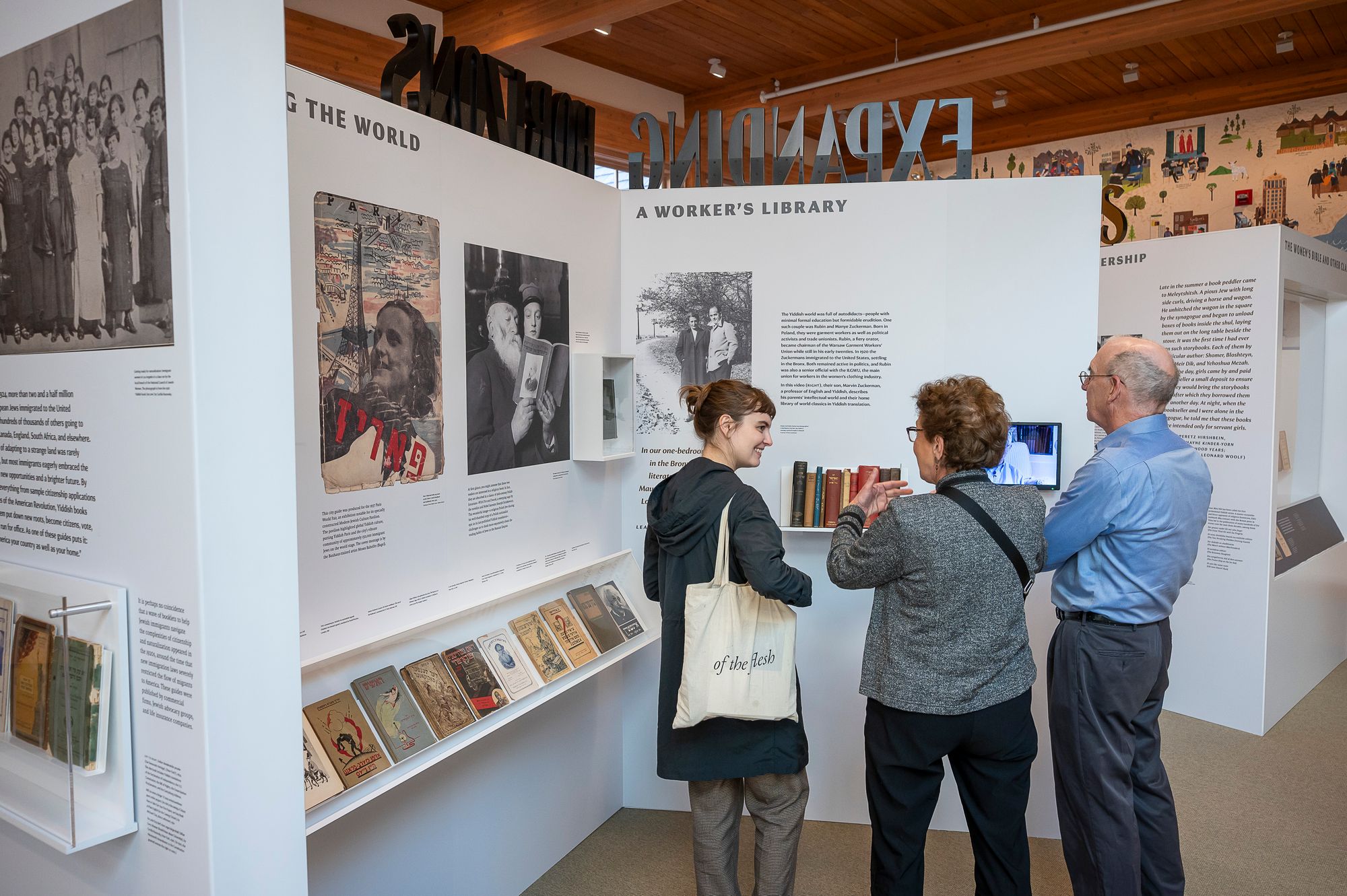Yiddish Book Center President To Step Down After 45 Years
Aaron Lansky founded the Yiddish Book Center in 1980, after realizing the literature was endangered. He will be stepping down as president in June 2025, but will still stay on two more years as a senior adviser. Susan Bronson, executive director, will assume the presidency.

Before Professor Ilan Stavans came to the United States, he grew up speaking Yiddish, the historic language of Eastern European Jews, in Mexico City. The language seemed to “have little practical use, with little future,” Stavans recalled.
“Only when I left Mexico and came to the US … did I realize that my Yiddish was something very unique, very valuable to me,” Stavans said.
During his graduate work at Columbia, Stavans learned about the Yiddish Book Center in Western Massachusetts. At that point, the center was housed in a rental unit in South Hadley and looking to make a permanent home in a shtetl-like, or small town-like, building on the Hampshire College campus.
“It was breathtaking to me that Yiddish could have this incipient research and educational institution taking place,” Stavans said. “I promised myself, in one way or another, to be connected to the place.”
He made the pilgrimage to the Pioneer Valley and knocked on founder and president Aaron Lansky’s door, praising his vision and accomplishments. They became instant friends, and their children grew up together. The two collaborated on many projects at the center.
Lansky, a MacArthur Foundation Genius Grant winner, founded the Yiddish Book Center in 1980 in what was supposed to be a pause in his graduate studies at McGill University. Because Yiddish literature was almost completely destroyed by Nazis in 1945, it became important to preserve the dusty, diminished copies that were overlooked by relatives who didn’t speak Yiddish.
Through talking to these owners of Yiddish books over kugel or a cup of tea, Lansky and other zamlers, or collectors, managed to come up with 1.5 million Yiddish books.
Now, the Yiddish Book Center’s archives are digitized, and the center hosts educational programs for all ages, an oral history project, a permanent exhibit, and even Yidstock, a summer music festival.
After 45 years, Lansky will be retiring as president in June 2025, but will stay on for two more years as a senior advisor. Susan Bronson, who has served as executive director for 14 years, will be taking on his role.
“When all is said and done, I was able to act on my dreams, save a literature, and reclaim a culture, and that, I think, makes me one of the world’s luckiest people. The Center will continue to flourish under the strong leadership of Susan Bronson and the work of our extraordinary team,” Lansky said in a press release.
Although the image of the Yiddish Book Center was strongly tied to Lansky, Stavans said, “he has done very well imagining what can happen after so that the institution can have a long-term life.”
Bronson, who was raised on the Upper West Side of Manhattan to Yiddish-speaking grandparents and has worked in the non-profit, higher education, and arts worlds, said she doesn’t think the transition will feel too dramatic.
“Of course, Aaron plays a huge role and is a major force in leading the center,” she said. “I’ve been lucky to work with him all this time. But I’m very comfortable with the Yiddish Book Center, with both the staff and our constituency.”

Bronson added that she will still be able to turn to Lansky when he becomes senior advisor.
Although Bronson doesn’t speak Yiddish herself, she says it doesn’t interfere with her capacity to run the organization, which is about bringing the culture to its audience. She added that it is people like her who should have learned Yiddish from their grandparents that demonstrate the need for the next generation to learn the language.
A Home for Yiddish in Amherst
“At that time, it was deemed adventurous, or maybe foolish, quixotic, when [Lansky] placed it in Amherst, Massachusetts, far from any Jewish cultural center,” Stavans said.
Because Lansky is a Hampshire College graduate, he started storing the Yiddish books in the Amherst area. At the time, Hampshire College was interested in building a “cultural village” and offered land to the Yiddish Book Center, Bronson said. It was significantly cheaper than it would have been in other places.
“The obvious choice [for its location] would have been New York, where Yiddish and Jewish culture has its epicenter in the United States,” Stavans said.
But when Lansky proposed the idea of the Yiddish Book Center, many of the existing Jewish organizations in major urban areas were dismissive, saying: “Yiddish is dead, why are you bothering with this?” Bronson said.
Despite the fact that a place like New York City would have a lot more foot traffic, Bronson said, Amherst became the Yiddish Book Center’s home.
Although the center took a long time to build, it has become a magnet, bringing people from all over the world to Amherst, Stavans added.
Its location within the Five College Consortium has also proved valuable for both students and the center.

The Yiddish Book Center is part of the Five College Museum consortium, which includes all the college museums in addition to the Eric Carle Museum, Emily Dickinson Museum, and Deerfield Historical Society. Bronson is in meetings with the respective directors regularly, and students can visit all of them for free.
Staff members at the center teach guest Yiddish classes at the Five Colleges, and the interlibrary loan system means that students can check out books easily from the center, “making our reservoir of material really inexhaustible,” Stavans said.
“While we’re based in Amherst, as a wonderful cultural asset in the Pioneer Valley, we have a footprint that is international,” Bronson said.
The Yiddish Book Center’s Digital Footprint
Ilya Nemirovsky ’24’s first time in Amherst was the summer after tenth grade, when he attended the Yiddish Book Center’s Great Jewish Books program, co-founded by Lansky and Stavans.
Since then, Nemirovsky has taken a Yiddish special topics class at the college and served as a Steiner Fellow at the center, completing a seven-week on-campus Yiddish immersion program at the center.
While working on his thesis on a Yiddish translation of King Lear, he struggled to find the script itself. After lots of scouring, he managed to obtain a copy from the catalogs of the Russian State Library.
“But then I figured that the Yiddish Book Center would have a PDF of it because they’ve digitized their collection. And so I found a PDF of this translation of King Lear, which is huge,” said Nemirovksy, who has also gotten suggestions for research directions and academic support from the center. “It’s crazy that something that is an archival find is ready, digitized and has immediate importance. It’s very difficult to overstate that value.”
The Steven Spielberg Digital Yiddish Library includes more than 11,000 titles available to read online or download free of charge.
Currently, the center is working on a Universal Yiddish digitized library in collaboration with the YIVO Institute for Jewish Research, New York Public Libraries, and the National Library of Israel.
“We were very early pioneers in digitizing,” Bronson said. “We’ve always had a robust website with a lot of online collections, but particularly since the pandemic, with the sort of explosion of virtual programming around the world, it certainly made it easier for us to reach audiences around the world.”
Looking to Future Generations
A big challenge the Yiddish Book Center faces is how to engage younger people, Bronson said.
“We have brought a lot of young people to the center and there’s a surge of interest in Yiddish among young people,” Bronson added. “We need to continue to build on that in order to sustain ourselves … and continue to support the Yiddish language and culture.”
The newly permanent exhibition, Yiddish: A Global Culture (which will soon be digitized so as to be widely accessible), has helped emphasize the importance of the language as something rooted in the present and future, not just the past.
The exhibit adds nuance to a previously nostalgic notion of the language. Yiddish was traditionally seen as the language of Eastern European Jews in a region pushed to extinction, Stavans said. The institution was rescuing what was left of the Yiddish culture that the Nazis destroyed.
The exhibit also points to the vibrancy and diversity of the places Jews moved to after leaving Eastern Europe: New York, Melbourne, Montreal, and Buenos Aires, among others.

A goal of the center is to underscore that, though the number of speakers has been diminished, Yiddish continues to offer a source of Jewish hope.
“In a time of rising antisemitism, the center represents a place of positivity, where you can learn about the richness of Yiddish culture, which is such a big part of Jewish history and engage with it in a meaningful way,” Bronson said.
Nemirovsky added that “many people struggle to find a really modern way to connect with their Jewishness.”
“They struggle with the religious connotations or ethnic connotations or Zionist connotations that are the mainstays of how you traditionally practice Jewishness,” Nemirovsky said. “So a lot of people have been using Yiddish as a sort of alternative mode of Jewish identity. And yet it’s enjoying quite a renaissance now, which is very exciting.”
Nemirovsky acknowledged that Yiddish-speaking Hasidim, a special movement within Orthodox Judaism, have continued to pass on the language to their many children, so the language is not dying.
“And yet, a lot of people in the Yiddish world have this unfortunate tendency of excluding the Hasidim as speakers and they still talk about it as if Yiddish is dying, because there’s no major secular Yiddish production,” Nemirovsky said.
In a conversation Nemirovsky had with Lansky, the founder and president talked about the importance of Hasidim, as these religious Jews are frequent visitors to the digitized collection.
Nemirovsky said he noticed Lansky’s passion in all of their interactions.
“He’s a typical Hampshire grad … it makes a lot of sense,” Nemirovsky added.
Lansky and the Yiddish Book Center have helped fill the gap of a lack of Jewish Studies programs at the college, Nemirovsky said.
“In a way, the [Yiddish Book Center] is much more needed here than in some place like New York or Boston because most colleges there have Jewish studies programs.”
Shayna Klainberg ’25 currently works as an archival assistant at the center and petitioned to have the Yiddish special topics class with a few friends.
“The fact that we couldn’t find a course on Yiddish being taught at any of the five colleges strikes me as something surprising,” Klainberg said. “It’s something that would be really important for Amherst to trailblaze and make that [a permanent course] offering.”
When working in the refrigerated underground archives, Klainberg dresses for the weather, receiving a constant flow of shipments, most recently one from South Africa. The books could be the only copy to exist, or one of over thirty, Klainberg said.
“In our current age of inheriting Yiddish culture, the center opens these doors,” Nemirovsky said. “I don’t think enough people know about the Yiddish Book Center, and it’s a shame.”





Comments ()